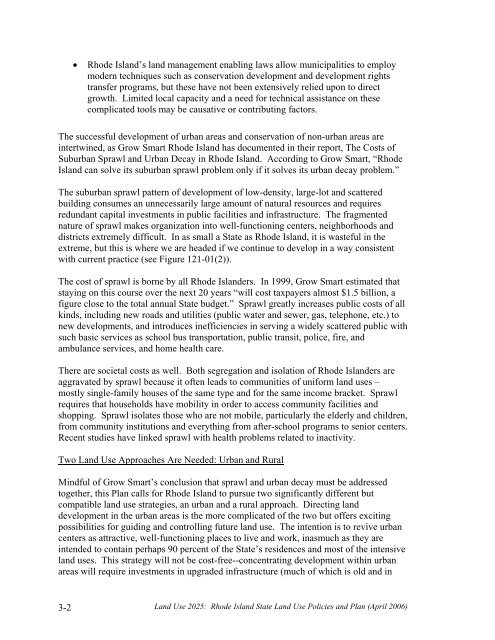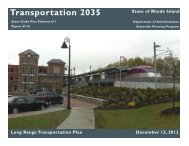Land Use 2025 - RhodeMap RI
Land Use 2025 - RhodeMap RI
Land Use 2025 - RhodeMap RI
- No tags were found...
Create successful ePaper yourself
Turn your PDF publications into a flip-book with our unique Google optimized e-Paper software.
• Rhode Island’s land management enabling laws allow municipalities to employmodern techniques such as conservation development and development rightstransfer programs, but these have not been extensively relied upon to directgrowth. Limited local capacity and a need for technical assistance on thesecomplicated tools may be causative or contributing factors.The successful development of urban areas and conservation of non-urban areas areintertwined, as Grow Smart Rhode Island has documented in their report, The Costs ofSuburban Sprawl and Urban Decay in Rhode Island. According to Grow Smart, “RhodeIsland can solve its suburban sprawl problem only if it solves its urban decay problem.”The suburban sprawl pattern of development of low-density, large-lot and scatteredbuilding consumes an unnecessarily large amount of natural resources and requiresredundant capital investments in public facilities and infrastructure. The fragmentednature of sprawl makes organization into well-functioning centers, neighborhoods anddistricts extremely difficult. In as small a State as Rhode Island, it is wasteful in theextreme, but this is where we are headed if we continue to develop in a way consistentwith current practice (see Figure 121-01(2)).The cost of sprawl is borne by all Rhode Islanders. In 1999, Grow Smart estimated thatstaying on this course over the next 20 years “will cost taxpayers almost $1.5 billion, afigure close to the total annual State budget.” Sprawl greatly increases public costs of allkinds, including new roads and utilities (public water and sewer, gas, telephone, etc.) tonew developments, and introduces inefficiencies in serving a widely scattered public withsuch basic services as school bus transportation, public transit, police, fire, andambulance services, and home health care.There are societal costs as well. Both segregation and isolation of Rhode Islanders areaggravated by sprawl because it often leads to communities of uniform land uses –mostly single-family houses of the same type and for the same income bracket. Sprawlrequires that households have mobility in order to access community facilities andshopping. Sprawl isolates those who are not mobile, particularly the elderly and children,from community institutions and everything from after-school programs to senior centers.Recent studies have linked sprawl with health problems related to inactivity.Two <strong>Land</strong> <strong>Use</strong> Approaches Are Needed: Urban and RuralMindful of Grow Smart’s conclusion that sprawl and urban decay must be addressedtogether, this Plan calls for Rhode Island to pursue two significantly different butcompatible land use strategies, an urban and a rural approach. Directing landdevelopment in the urban areas is the more complicated of the two but offers excitingpossibilities for guiding and controlling future land use. The intention is to revive urbancenters as attractive, well-functioning places to live and work, inasmuch as they areintended to contain perhaps 90 percent of the State’s residences and most of the intensiveland uses. This strategy will not be cost-free--concentrating development within urbanareas will require investments in upgraded infrastructure (much of which is old and in3-2 <strong>Land</strong> <strong>Use</strong> <strong>2025</strong>: Rhode Island State <strong>Land</strong> <strong>Use</strong> Policies and Plan (April 2006)
















